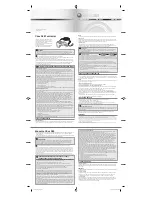
Stagehand Pro 3 Reference Manual, 11-20
Page 11 of 56
reduce the time it takes to engage the brake. If you are using a load brake you should use
fast-brake switching.
It is important to hook up the correct brake to the designated terminals of the connector. Load
brakes are typically much slower to respond than motor brakes because of their necessary size.
When moving the motor, the Stagehand will first release the load brake, wait 500ms for the brake to
fully release, and then release the motor brake and start spinning the motor. The Stagehand uses
this sequencing to make sure that the motion of your machine is smooth and quiet. If the load brake
isn’t allowed time to fully disengage then the machine will drive through the partially-engaged brake
which prematurely wears the brake and makes a distracting noise. If you mistakenly swap the load &
motor brake wires, the brake release sequence will be wrong, and the machine will make a loud
creak at the beginning of each movement.
Signal
Two sets of encoder signals (one for speed monitoring and one for positioning) and three sets of limit
switches (forward, reverse, and ultimate) are combined in one rectangular connector (ILME CDDF-24).
All limit switch signals require Normally Closed (N.C.) switches. The Stagehand sources 12vdc on a
pin of each limit circuit and expects to see that 12vdc signal returned on the other pin when the limit
is not activated. If the limit is either activated or disconnected or a wiring fault occurs, the 12vdc
return signal is lifted and the Stagehand will enter a limit fault condition and disallow motion.
The limit switch inputs are used to protect against the motor traveling too far in a direction and
causing damage or injury. When running in a cue, this is one of the safety features that guards
against encoder failure. When jogging manually, this keeps you from accidentally traveling too far.
All encoder signals use differential line receivers which use a balanced signal transmitted over
twisted-pair wires to drastically reduce electrical interference and thus reduce the opportunity for
inaccurate encoder data. Encoders connected to the Stagehand must be equipped with differential
line drivers to be compatible. Encoders are powered at 5vdc for broadest compatibility.
Summary of Contents for Stagehand Pro 3
Page 1: ...Copyright 2020 Creative Conners Inc STAGEHAND PRO 3 REFERENCE MANUAL 1 1...
Page 2: ...Stagehand Pro 3 Reference Manual 11 20 Index...
Page 21: ...Stagehand Pro 3 Reference Manual 11 20 Page 15 of 56 Single encoder Dual encoders...
Page 22: ...Stagehand Pro 3 Reference Manual 11 20 Page 16 of 56 Ethernet...
Page 29: ...Stagehand Pro 3 Reference Manual 11 20 Page 23 of 56...
Page 30: ...Stagehand Pro 3 Reference Manual 11 20 Page 24 of 56...
Page 53: ...Stagehand Pro 3 Reference Manual 11 20 Page 47 of 56 SPECIFICATIONS Physical Specifications...
Page 60: ...Stagehand Pro 3 Reference Manual 11 20 Page 54 of 56 PLC Ladder Logic...
Page 61: ...Stagehand Pro 3 Reference Manual 11 20 Page 55 of 56...
Page 63: ...Stagehand Pro 3 Reference Manual 11 20 Page 57 of 56...
















































